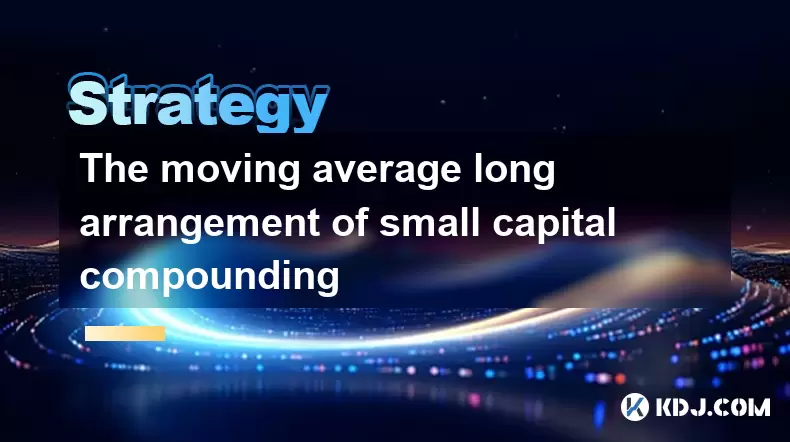-
 bitcoin
bitcoin $87959.907984 USD
1.34% -
 ethereum
ethereum $2920.497338 USD
3.04% -
 tether
tether $0.999775 USD
0.00% -
 xrp
xrp $2.237324 USD
8.12% -
 bnb
bnb $860.243768 USD
0.90% -
 solana
solana $138.089498 USD
5.43% -
 usd-coin
usd-coin $0.999807 USD
0.01% -
 tron
tron $0.272801 USD
-1.53% -
 dogecoin
dogecoin $0.150904 USD
2.96% -
 cardano
cardano $0.421635 USD
1.97% -
 hyperliquid
hyperliquid $32.152445 USD
2.23% -
 bitcoin-cash
bitcoin-cash $533.301069 USD
-1.94% -
 chainlink
chainlink $12.953417 USD
2.68% -
 unus-sed-leo
unus-sed-leo $9.535951 USD
0.73% -
 zcash
zcash $521.483386 USD
-2.87%
The moving average long arrangement of small capital compounding
Moving averages help traders identify trends and entry points, crucial for compounding small capital in crypto trading while managing risk effectively.
May 31, 2025 at 10:21 pm

Understanding Moving Averages in Cryptocurrency Trading
In the world of cryptocurrency trading, moving averages are a fundamental tool used by traders to identify trends and potential entry or exit points in the market. A moving average smooths out price data by creating a constantly updated average price, which can be calculated over different time periods, such as 50-day, 100-day, or 200-day moving averages. When it comes to small capital compounding, understanding and utilizing moving averages can be particularly beneficial as it helps in making informed decisions without risking large sums of money.
The Concept of Long Arrangement in Moving Averages
The term long arrangement in the context of moving averages refers to a situation where shorter-term moving averages are positioned above longer-term moving averages. This setup is often interpreted as a bullish signal, indicating that the asset's price is trending upwards. For traders with small capital, recognizing such patterns can be crucial as it helps in deciding when to enter the market to maximize potential gains through compounding.
Compounding Small Capital Using Moving Averages
Compounding in trading refers to reinvesting profits to generate additional earnings. When it comes to small capital, the strategy becomes even more critical as the initial investment is limited. By using moving averages to identify long arrangements, traders can make calculated decisions to buy low and sell high, thereby compounding their returns over time. This method requires patience and discipline, as the gains may be small in the beginning but can grow significantly through consistent application.
Implementing a Moving Average Strategy for Small Capital
To implement a moving average strategy for small capital compounding, traders need to follow a systematic approach. Here are the steps involved:
- Choose the Right Moving Averages: Select moving averages that align with your trading timeframe. For example, if you are a short-term trader, you might use a 5-day and a 20-day moving average. For longer-term trading, consider using a 50-day and a 200-day moving average.
- Identify Long Arrangements: Monitor the price chart to spot when the shorter moving average crosses above the longer moving average, indicating a potential buy signal.
- Enter the Market: Use the identified long arrangement to enter the market. Since you are dealing with small capital, consider using a small portion of your funds for each trade to minimize risk.
- Monitor and Adjust: Keep an eye on the moving averages and the price action. If the long arrangement persists and the price continues to trend upwards, hold your position. If the trend reverses, consider exiting the trade to lock in profits or cut losses.
- Reinvest Profits: Once you have made a profit, reinvest it into new trades following the same moving average strategy. This is the essence of compounding with small capital.
Risk Management in Small Capital Compounding
When dealing with small capital, risk management is paramount. Even though moving averages can provide valuable insights, the cryptocurrency market is highly volatile, and losses can occur. To mitigate risks, consider the following:
- Use Stop-Loss Orders: Set stop-loss orders to automatically sell your position if the price drops to a certain level, thus limiting potential losses.
- Diversify Your Portfolio: Instead of putting all your small capital into one cryptocurrency, spread it across different assets to reduce the impact of a single asset's poor performance.
- Keep Emotions in Check: Stick to your moving average strategy and avoid making impulsive decisions based on short-term market fluctuations.
Analyzing the Effectiveness of Moving Average Long Arrangements
The effectiveness of using moving average long arrangements for small capital compounding can vary depending on market conditions and the specific cryptocurrencies being traded. Historically, this strategy has been successful in trending markets where prices move in a sustained direction. However, during periods of high volatility or sideways markets, moving averages might generate false signals, leading to potential losses. Therefore, it is essential to backtest your strategy using historical data to understand its performance under different market scenarios.
Tools and Resources for Implementing Moving Average Strategies
To effectively implement a moving average strategy for small capital compounding, traders can utilize various tools and resources available in the cryptocurrency market. Some of these include:
- Trading Platforms: Platforms like Binance, Coinbase, and Kraken offer built-in charting tools where you can add moving averages to analyze price trends.
- Technical Analysis Software: Software like TradingView and MetaTrader provides advanced charting capabilities and the ability to customize moving averages according to your strategy.
- Educational Resources: Websites, forums, and YouTube channels dedicated to cryptocurrency trading can offer valuable insights and tutorials on using moving averages effectively.
FAQs
Q: Can moving average strategies be used for all cryptocurrencies?A: While moving average strategies can be applied to most cryptocurrencies, their effectiveness may vary depending on the liquidity and volatility of the specific asset. More liquid assets like Bitcoin and Ethereum tend to respond better to moving average signals compared to less liquid altcoins.
Q: How often should I check my moving averages when compounding with small capital?A: The frequency of checking moving averages depends on your trading timeframe. For short-term traders, daily checks might be necessary, while long-term traders might review their charts weekly or monthly. It's important to find a balance that suits your trading style without leading to overtrading.
Q: What is the ideal percentage of small capital to allocate to each trade?A: There is no one-size-fits-all answer, but a common rule of thumb is to risk no more than 1-2% of your total capital on any single trade. This approach helps in managing risk and preserving capital for future compounding opportunities.
Q: How can I improve my moving average strategy for better results?A: To improve your moving average strategy, consider combining it with other technical indicators like the Relative Strength Index (RSI) or the Moving Average Convergence Divergence (MACD) to confirm signals. Additionally, continuous learning and adapting to market changes can enhance your trading performance.
Disclaimer:info@kdj.com
The information provided is not trading advice. kdj.com does not assume any responsibility for any investments made based on the information provided in this article. Cryptocurrencies are highly volatile and it is highly recommended that you invest with caution after thorough research!
If you believe that the content used on this website infringes your copyright, please contact us immediately (info@kdj.com) and we will delete it promptly.
- Bitcoin's MVRV Model Flashes Bear, But Whales Wager on a Quiet Bull Thesis
- 2025-12-13 12:45:01
- Easy S1 Stagnation Shadows Binance Outflows: A Market Snapshot
- 2025-12-13 12:55:01
- Bhutan's Bold Blockchain Strategy: Launching a Sovereign Gold Token for a Digital Future
- 2025-12-13 09:50:02
- DATCO Advantage: New York's Digital Asset Dynamos Eye Growth Surge, 2026 Outlook Shines
- 2025-12-13 09:50:02
- Mystery Donor's Golden Touch Illuminates Salvation Army Kettles from Vermont to Chicago
- 2025-12-13 07:00:02
- Cryptocurrency Landscape: Polkadot's ETF Surge, Curve's DeFi Dominance, and Cardano's Consolidation
- 2025-12-13 09:45:01
Related knowledge

Why My "Gut Feeling" About Crypto Is Always Wrong.
Dec 07,2025 at 07:00am
Emotional Triggers in Market Participation1. Fear of missing out (FOMO) drives impulsive buys during sharp price surges, often right before a correcti...

How to Build a Crypto Strategy That Works Even When You're Wrong.
Dec 07,2025 at 10:19am
Understanding Market Cycles1. Cryptocurrency markets operate in distinct phases: accumulation, markup, distribution, and markdown. These phases repeat...

How to Stop Treating Crypto Like a Casino and Start Building Wealth.
Dec 08,2025 at 02:00am
Understanding the Fundamentals1. Cryptocurrencies are not just speculative instruments—they represent protocols, networks, and economic systems with m...

Why Does Crypto Feel Rigged Against the Small Investor?
Dec 11,2025 at 01:00pm
Market Structure Imbalances1. Large institutional players control order flow through direct exchange connections, co-location servers, and API privile...

The Fear of Missing Out (FOMO) vs. The Fear of Losing Everything (FUD): Which Is Worse?
Dec 09,2025 at 11:40am
FOMO in Cryptocurrency Markets1. FOMO emerges when traders observe rapid price surges in assets like Bitcoin or meme coins without participating in th...

"I Should Have Bought More": How to Deal with Post-Pump Regret.
Dec 07,2025 at 04:19pm
Understanding the Psychology Behind FOMO1. The human brain processes gains and losses asymmetrically, assigning greater emotional weight to missed opp...

Why My "Gut Feeling" About Crypto Is Always Wrong.
Dec 07,2025 at 07:00am
Emotional Triggers in Market Participation1. Fear of missing out (FOMO) drives impulsive buys during sharp price surges, often right before a correcti...

How to Build a Crypto Strategy That Works Even When You're Wrong.
Dec 07,2025 at 10:19am
Understanding Market Cycles1. Cryptocurrency markets operate in distinct phases: accumulation, markup, distribution, and markdown. These phases repeat...

How to Stop Treating Crypto Like a Casino and Start Building Wealth.
Dec 08,2025 at 02:00am
Understanding the Fundamentals1. Cryptocurrencies are not just speculative instruments—they represent protocols, networks, and economic systems with m...

Why Does Crypto Feel Rigged Against the Small Investor?
Dec 11,2025 at 01:00pm
Market Structure Imbalances1. Large institutional players control order flow through direct exchange connections, co-location servers, and API privile...

The Fear of Missing Out (FOMO) vs. The Fear of Losing Everything (FUD): Which Is Worse?
Dec 09,2025 at 11:40am
FOMO in Cryptocurrency Markets1. FOMO emerges when traders observe rapid price surges in assets like Bitcoin or meme coins without participating in th...

"I Should Have Bought More": How to Deal with Post-Pump Regret.
Dec 07,2025 at 04:19pm
Understanding the Psychology Behind FOMO1. The human brain processes gains and losses asymmetrically, assigning greater emotional weight to missed opp...
See all articles










































































